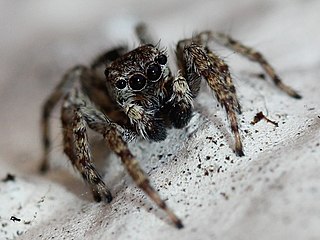
Pelegrina is a spider genus of the family Salticidae. They are found throughout North America. Many of the species in Pelegrina were previously placed in the genera Metaphidippus, and before that, Dendryphantes. The genus was originally described in 1930 by the Spanish arachnologist Pelegrín Franganillo Balboa, who named it after himself.
Pelegrina insignis is a species of jumping spider in the family Salticidae. It is found in the United States and Canada.
Pelegrina flavipes is a species of jumping spider in the family Salticidae. It is found in the United States and Canada.

Pelegrina pervaga is a species of jumping spider in the family Salticidae. It is found in the United States.
Pelegrina sabinema is a species of jumping spider in the family Salticidae. It is found in the United States.

Pelegrina aeneola is a species of jumping spider in the family Salticidae. It is found in North America.

Pelegrina exigua is a species of jumping spider in the family Salticidae. It is found in the United States.

Hentzia mitrata, the white-jawed jumping spider, is a species of jumping spider in the family Salticidae. It is found in the United States, Canada, and Bahama Islands.

Paraphidippus basalis is a species of jumping spider in the family Salticidae. It is found in Arizona and New Mexico, United States, and Sonora, Mexico. Paraphidippus basalis specializes on rosette-forming plants such as agaves, sotols, and yuccas. This specialization on a single group of plants is rare among jumping spiders.
Habronattus sansoni is a species of jumping spider in the family Salticidae. It is found in the United States and Canada.
Habronattus forticulus is a species of jumping spider in the family Salticidae. It is found in the United States and Mexico.
Naphrys acerba is a species of jumping spider in the family Salticidae. It is found in the United States and Mexico.
Phidippus tux, the jumping spider, is a species of jumping spider in the family Salticidae. It is found in the United States and Mexico.

Mexigonus minutus is a species of jumping spider in the family Salticidae. It is found in the United States and Mexico.
Phidippus cryptus is a species of jumping spider in the family Salticidae. It is found in the United States and Canada.
Habronattus tranquillus is a species of jumping spider in the family Salticidae. It is found in the United States and Mexico.
Attidops cinctipes is a species of jumping spider in the family Salticidae. It is found in the United States.

Habronattus klauseri is a species of jumping spider. It is found in the western United States and Mexico.

Phidippus apacheanus is a species of jumping spider in the family Salticidae. It is found in the United States, Mexico, and Cuba.
Pellenes longimanus is a species of jumping spider in the family Salticidae. It is found in the United States.









